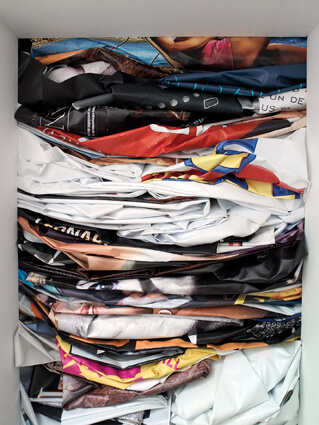
© Jeu de Paume
Exhibition
Klara Lidén: "Always Be Elsewhere"
Satellite programm 3 /Curator: Elena Filipovic
From 29 June to 05 September 2010
Jeu de Paume – Paris
Trained in art and architecture, Swedish artist Klara Lidén (born Stockholm, 1979) often uses
architectural interventions, hijacked materials, and the spaces behind something else to expose
some of the conventions on which society is based. In Elda för kråkorna (2008), she built up a series of makeshift walls from existing materials to create a new invisible space within a gallery to house local pigeons. Not only did it provide useless “heating for pigeons” (as its Swedish title, a local saying, is literally translated), but it also made the commercial gallery a negative space, accompanied by the noise (and the imaginable mess) of the birds. In other instances, she created an underground structure for living built on municipal property in Berlin, operated a year-long free alternative postal system in Stockholm, and reversed the usual logic of a commercial art fair to create an installation that was hidden behind one of the walls of her gallery’s booth—a kind of space to escape from the fair, which could be entered and occupied by anyone who dared to traverse its hidden entrance. In those projects, as in many of her short films, it is a politics of the body that is perhaps most at stake. As the artist herself once commented: “whether in a
museum or my own apartment, […] the question of re-appropriating privatized, urban space always somehow begins with the body, its ways of moving and the temporalities it engages…”
Her new project for Jeu de Paume, “Always Be Elsewhere”, is, as with much of her work, a
site-specific intervention. It includes a sculptural installation composed of layers of used advertising tarpaulins, of the kind that usually cover buildings and thus line the visual field of our public space. Here, they fill and, inevitably, block the entrance to a room of the institution, so that visitors cannot easily perceive the actual dimensions of one of the exhibition spaces. The installation protrudes beyond the borders of the space, connecting and indirectly relating to three new “filmic” slide shows visible in the lower galleries. The slide shows employ Lidén’s own specially conceived do-it-yourself technique: the artist begins by making a film with her handheld
video camera and then prints a selection of its video stills on transparent paper with a cheap
inkjet printer and places the results between glass projection slides. These endow the images with a particular materiality (gritty black and white yet almost pointillist in aspect) and also allow Lidén
to determine their temporality: although each is based on a single action filmed without cuts and
in real time, the artist creates a decided tension and new sense of cinematic “time” when they are
presented as a slide show. They are combined with a soundtrack whose repetitions underscore the intensity of the experience of the three differently paced slide projections. These poetically expand the combination of angst, alienation, and quirky humor of her oeuvre, each demonstrating a small but derisive action performed by the artist herself—such as Lidén diving into the River Seine with her video camera—that disobey the unwritten rules of “proper” behavior. The exhibition as a whole testifies to the artist’s persistent desire to, as she once wrote, “divert materials or spaces”—and, one could add, bodies— “from their prescribed functions, inventing ways of
making these things improper again.”
Elena Filipovic, curator of the exhibition
Exhibition produced with the support of
the Fondation nationale des arts graphiques et plastiques,
and iaspis,
in collaboration with Metropole Atelier,
the Cité des Arts, and the Institut suédois à Paris,
in partnership with Arte, art press,
Mouvement et mouvement.net, Nova,
parisart.com, souvenirs from earth TV
